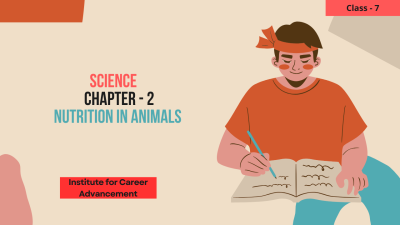Course description
Here's a structured course overview typically covered:
Introduction to Nutrition:
Definition of nutrition and its importance for animals.
Different modes of nutrition: herbivores, carnivores, omnivores, and parasites.
Digestive System:
Structure and function of the digestive system.
Organs involved: mouth, esophagus, stomach, small intestine, large intestine, and associated glands (liver, pancreas).
Processes: ingestion, digestion (mechanical and chemical), absorption, and egestion.
Digestive Processes:
Mechanical digestion: chewing, grinding (teeth), and churning (stomach).
Chemical digestion: enzymes and their role in breaking down carbohydrates, proteins, and fats into simpler forms.
Nutrient Groups:
Carbohydrates, proteins, fats (lipids), vitamins, minerals, and water.
Functions and sources of each nutrient group.
Digestive Adaptations:
Adaptations in different animal species based on their diet (e.g., herbivores have longer digestive tracts for cellulose digestion).
Food Chains and Food Webs:
Understanding animals' roles as consumers (primary, secondary, tertiary) in food chains and webs.
Energy flow through ecosystems and trophic levels.
Energy Balance:
Caloric intake and expenditure.
Energy storage (as glycogen and fats) and utilization in metabolic processes.
Health and Nutrition:
Importance of balanced nutrition for animal health and growth.
Consequences of nutrient deficiencies and imbalances.
Comparative Anatomy:
Comparison of digestive systems across animal groups (mammals, birds, reptiles, etc.).
How anatomy relates to diet and habitat.
Applications and Real-life Examples:
Practical applications in animal husbandry, wildlife conservation, and understanding ecological interactions.
Case studies illustrating the impact of nutrition on animal health and population dynamics.
এখানে একটি কাঠামোগত কোর্সের ওভারভিউ সাধারণত কভার করা হয়:
পুষ্টির ভূমিকা:
পুষ্টির সংজ্ঞা এবং প্রাণীদের জন্য এর গুরুত্ব।
পুষ্টির বিভিন্ন পদ্ধতি: তৃণভোজী, মাংসাশী, সর্বভুক এবং পরজীবী।
পাচনতন্ত্র:
পাচনতন্ত্রের গঠন এবং কার্যকারিতা।
জড়িত অঙ্গ: মুখ, খাদ্যনালী, পাকস্থলী, ছোট অন্ত্র, বড় অন্ত্র এবং সংশ্লিষ্ট গ্রন্থি (লিভার, অগ্ন্যাশয়)।
প্রক্রিয়া: ইনজেশন, হজম (যান্ত্রিক এবং রাসায়নিক), শোষণ এবং ইজেশন।
হজম প্রক্রিয়া:
যান্ত্রিক হজম: চিবানো, নাকাল (দাঁত), এবং মন্থন (পেট)।
রাসায়নিক হজম: এনজাইম এবং তাদের ভূমিকা কার্বোহাইড্রেট, প্রোটিন এবং চর্বিকে সহজ আকারে ভাঙতে।
পুষ্টির গ্রুপ:
কার্বোহাইড্রেট, প্রোটিন, চর্বি (লিপিড), ভিটামিন, খনিজ এবং জল।
প্রতিটি পুষ্টি গ্রুপের কাজ এবং উৎস।
হজমের অভিযোজন:
তাদের খাদ্যের উপর ভিত্তি করে বিভিন্ন প্রাণীর প্রজাতির অভিযোজন (যেমন, তৃণভোজীদের সেলুলোজ হজমের জন্য দীর্ঘতর পরিপাকতন্ত্র থাকে)।
ফুড চেইন এবং ফুড ওয়েব:
খাদ্য শৃঙ্খল এবং জালে ভোক্তা (প্রাথমিক, মাধ্যমিক, তৃতীয়) হিসাবে প্রাণীদের ভূমিকা বোঝা।
বাস্তুতন্ত্র এবং ট্রফিক স্তরের মাধ্যমে শক্তি প্রবাহ।
শক্তি ভারসাম্য:
ক্যালরি গ্রহণ এবং ব্যয়।
শক্তি সঞ্চয় (গ্লাইকোজেন এবং চর্বি হিসাবে) এবং বিপাকীয় প্রক্রিয়াগুলিতে ব্যবহার।
স্বাস্থ্য এবং পুষ্টি:
পশু স্বাস্থ্য এবং বৃদ্ধির জন্য সুষম পুষ্টির গুরুত্ব।
পুষ্টির ঘাটতি এবং ভারসাম্যহীনতার পরিণতি।
তুলনামূলক অ্যানাটমি:
পশু গোষ্ঠী (স্তন্যপায়ী, পাখি, সরীসৃপ, ইত্যাদি) জুড়ে পরিপাকতন্ত্রের তুলনা।
কিভাবে শারীরস্থান খাদ্য এবং বাসস্থানের সাথে সম্পর্কিত।
অ্যাপ্লিকেশন এবং বাস্তব জীবনের উদাহরণ:
পশুপালন, বন্যপ্রাণী সংরক্ষণ এবং পরিবেশগত মিথস্ক্রিয়া বোঝার ক্ষেত্রে ব্যবহারিক প্রয়োগ।
প্রাণী স্বাস্থ্য এবং জনসংখ্যার গতিশীলতার উপর পুষ্টির প্রভাবকে চিত্রিত করে কেস স্টাডি।



















